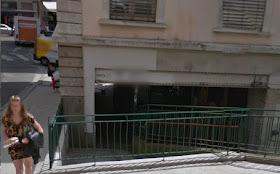We begin our investigations at Gare St Paul in Lyon, France.
This station is located in the "Old Town" near the River Saône.
On the aerial view, please note the grey splodge centre left. This is the Cimetière de Loyasse, being easily translated at a "cemetery". In the picture of the station frontage above, note first the radio tower, top left and, secondly, the open "gateway" in the building on the left of the station.
If we were to go and peer into the darkness, we might see ...
... a motor scooter and a road sign. Odd? If we look from the other end we can see right through.
Curiouser and curiouser? A helpful on-line chappie has been inside and photographed two parked cars.
Those stone slabs look like they were once the edge of something.
And indeed they were. This was the base station of the Funiculaire de Fouvière aka
Funiculaire de Loyasse.
En 1893, Monsieur Cornillon dépose une demande de concession pour la construction d’un funiculaire entre la gare Saint Paul et Fourvière, et d’un tramway en correspondance entre Fourvière et le grand cimetière lyonnais de Loyasse. L’idée étant d’assurer une desserte du cimetière aussi bien pour les vivants, que pour les personnes devant y être enterrées.
Monsieur Cornillon saw a need for transport from Lyon, up the hill and on to the Cemetery. The funicular was the first stage and built in tunnel.
Comble de malchance, le tunnel du funiculaire possède des faiblesses structurelles, car percé dans un terrain peu stable. Ceci sera une source de contentieux avec les riverains, et en particulier les pères maristes qui voient avec inquiétude leurs immeubles se fissurer. (seeing their property cracking!) Il nécessitera un confortement majeurs qui entraîneront l’interruption des circulations entre décembre 1923 et le 22 octobre 1925. (two year closure!)
The tunnel was weak and subject to failure and the whole project was a financial disaster. The top station was near the tower ...
... which originally has a restaurant with a lift up to a viewing platform, popular with residents and visitors alike.
The Tour Métallique de Fourvière ("Metallic tower of Fourvière") is a steel framework tower which bears a striking resemblance to the Eiffel Tower, which predates it by three years. With a height of 85.9 metres and weight of 210 tons, the "metallic tower" was built between 1892 and 1894.
During the Exposition universelle of 1914 it had a restaurant and a lift capable of taking 22 people up to the viewing gallery. Although used as an observation tower until November 1, 1953, nowadays it serves as a television tower and is not accessible to the public. At 372m, it is the highest point in Lyon.
The people of Lyon have been known to claim that their tower is higher that that built by Gustave Eiffel in Paris. But that's measuring from sea level! By that spurious definition it is indeed 50 metres "higher" than its Parisian cousin!
But at its base you needed to change from funicular to a tram (on the left in the "tower" picture above) to get the the Cemetery. The construction of this short line involved a substantial (and expensive!) viaduct and girder bridge.
The Tour Métallique de Fourvière ("Metallic tower of Fourvière") is a steel framework tower which bears a striking resemblance to the Eiffel Tower, which predates it by three years. With a height of 85.9 metres and weight of 210 tons, the "metallic tower" was built between 1892 and 1894.
During the Exposition universelle of 1914 it had a restaurant and a lift capable of taking 22 people up to the viewing gallery. Although used as an observation tower until November 1, 1953, nowadays it serves as a television tower and is not accessible to the public. At 372m, it is the highest point in Lyon.
The people of Lyon have been known to claim that their tower is higher that that built by Gustave Eiffel in Paris. But that's measuring from sea level! By that spurious definition it is indeed 50 metres "higher" than its Parisian cousin!
But at its base you needed to change from funicular to a tram (on the left in the "tower" picture above) to get the the Cemetery. The construction of this short line involved a substantial (and expensive!) viaduct and girder bridge.
Face aux résultats financiers désastreux de la ficelle, dont la machinerie toujours mue à la vapeur est la dernière de ce type sur le réseau depuis une vingtaine d’années, et du tramway, la compagnie exploite le matériel jusqu’à la limite d’usure, et ferme (closed) le funiculaire le 25 décembre 1937.
There is little to see at the summit station but ...
... note the remnants of an archway in the white wall; but the viaduct has been refurbished and is now a popular footpath.
For the technically minded, the actual walkway is new, but installed on the old piers; the original trackbed was deemed to be in too decayed a state to refurbish.
Lyon had FIVE funicular railways of which two are still working, both in the Old Town and connecting with Metro route "D" at Saint Jean..
The Saint Just line is very modern ...
... whereas the Fourvière line is run as a "Heritage" service using refurbished older stock.
Interestingly (?) the Fourvière line terminates just along the road from the historic but closed funicular plus tram route!
Lyon had FIVE funicular railways of which two are still working, both in the Old Town and connecting with Metro route "D" at Saint Jean..
The Saint Just line is very modern ...
... whereas the Fourvière line is run as a "Heritage" service using refurbished older stock.
Interestingly (?) the Fourvière line terminates just along the road from the historic but closed funicular plus tram route!
Next tram/train/tram blog : Wednesday 14th October
















No comments:
Post a Comment